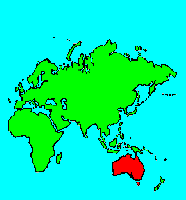SPECIES INFO
Australian brown tree snake (Boiga irregularis) is native to extreme northern Australia and a somewhat larger area in northwestern Australia. There are closely related forms in eastern Indonesia and on New Guinea. This snake is part of the rear fanged snake group. The brown tree snake has a large head that is much wider than the rest of the body. This snake can reach over 6 feet in length. There are two forms found on Australia. One is darker than the other, but both have non-linear dark bands around the top of the body. This snake is a known tree climber and it can be found in the attics of buildings.
This large snake eats various large insects, small birds, and small mammals. This snake is a threat to numerous species around the world. It has changed the balance of nature on Guam. Very expensive measures are being taken in Hawaii to prevent its accidental introduction to those islands.Cat snakes (Genus Boiga) are medium to large tree-climbing snakes native to Africa and southern Asia. They are also found east into the Philippines and through Indonesia into Australia. This genus contains about 30 species. These rear-fanged snakes are mildly poisonous. Most species have a vertical pupil giving them the common name of cat snakes. The brown tree snake is a problem in Guam and has generated concern that it might accidentally be introduced elsewhere. Consequently, planes and boats from Guam are carefully searched.
Family Colubridae contains the vast majority (70% of all snakes) of the world's species of snakes. The number is estimated to be over 1,850 and possibly up to 2,500.
Lizards and Snakes (Squamata Order) share many common characteristics and consequently they are grouped in a single order. There are greater differences between some groups of lizards than there are between other groups of lizards and snakes. The same is true of snakes. Lizards and snakes share a common skull shape.
There are perhaps 4,000 species of lizards and perhaps 2,700 species of snakes alive today. In the Great Big Book of Snakes and Reptiles published in 2014, they noted the above estimates.
Reptiles (Class Reptilia) are an ancient group of scaled chordates. These scales may be permanently joined, as in the turtles, or flexible, as in the snakes. Reptiles are land-based. Their eggs are laid on land and the young are air breathing.
In the Great Big Book of Snakes and Reptiles published in 2014, they noted that there are more than 7,000 species of reptiles alive today.
Backboned Animals (Phylum Chordata) are the most advanced group of animals on earth. These animals are characterized by having a spinal cord or backbone. Most members have a clearly defined brain that controls the organism through a spinal cord. Fish, amphibians, reptiles, birds, and mammals are in this phylum.
Currently, some taxonomists believe that the fish should be divided into two groups (sharks and regular fishes) and that there are some other primitive groups in the phylum such as hagfish or lampreys.
Animal Kingdom contains numerous organisms that feed on other animals or plants. Included in the animal kingdom are the lower marine invertebrates such as sponges and corals, the jointed legged animals such as insects and spiders, and the backboned animals such as fish, amphibians, reptiles, birds, and mammals.

